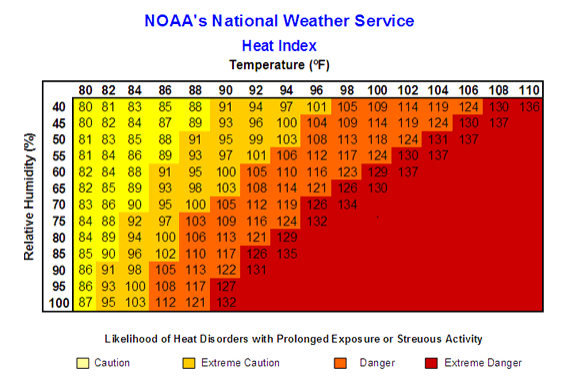Our workforce is constantly exposed to risk on the job, and warm weather (especially in the Southeastern U.S.) is an additional risk to us all during the summer months. Heat, whether it is from natural or artificial sources, or it occurs in an indoor or outdoor environment, causes sickness and even death to people each and every year.
In our modern world, however, we believe that this is entirely preventable.
Let’s take a deeper dive into heat – how we can assess risks associated with exposure to heat – and ultimately work to eliminate it as a cause of illness on the job altogether.
Where is HEAT found?
Heat occurs in both indoor and outdoor areas. Essentially heat exists in any place involving high air temperatures, radiant heat sources (think: the Sun), high humidity, or direct contact with hot objects or equipment.
Why is HEAT a safety risk?
When a person walks onto a jobsite where heat (in one form or another) is prevalent, the body works to remove the excess heat that exists to maintain an appropriate and stable internal temperature. The body accomplishes this by increasing the circulation of blood and by sweating – which cools the outer layer of the skin through evaporation, resulting in a drop in body temperature.
When the ambient air temperature increases to a point greater than our internal body temperature, the body works harder to cool itself. As heat levels rise, the increase in circulation does not adequately remove enough heat, therefore the only other way to decrease the overall body temperature is through sweating. However, sweating is only effective if the humidity level is low enough to allow for evaporation. Moreover, it can become increasingly dangerous if the fluids and salts lost from the body during sweating are not adequately replaced in a timely fashion. If the body struggles to remove heat through these means, it can then only store it internally, which can cause significant health risks such as dehydration, high heart rate levels, concentration loss, headaches, fainting, total exhaustion, and even death.
What are the types of HEAT related illnesses?
- Heat Stroke – happens when the body becomes unable to regulate its core internal temperature. This is by far the most serious form of a heat related illness. Warning signs include confusion, seizures, and total loss of consciousness.
- Heat Exhaustion – the body’s response to the loss of fluids and water through sweating. Warning signs include headaches, dizziness, weakness, nausea, and extreme thirst.
- Heat Cramps – also caused by the loss of bodily fluids through sweating. Results in painful muscle cramping during or after work is performed.
- Heat Rash – a skin condition caused by sweat that does not evaporate from the skin. This appears as red bumps or reddish areas, typically on the face, neck and chest areas.
Who is affected by HEAT?
Individuals who are exposed to hot or humid conditions, working in or around hot equipment, and those performing heavy tasks or wearing bulky clothing or non-breathable PPE are all at risk of heat related illnesses.
How do I know if I am at risk?
See the Heat Index chart below to understand your risk:
How can I prevent a HEAT related illness?
Engineering Controls:
- Air Conditioning
- Adequate ventilation
- Cooling fans
- Reflective shields
- Insulation of hot surfaces
Work Practices:
- Emergency plan in place
- Adequate drinkable water supply
- Work / Rest schedules
- Rotating job functions
- “Watch each other’s backs”
Training:
- Personal Protective Equipment (PPE) suitable for warm weather conditions
- How to recognize warning signs
- Procedure on how to respond to heat related illnesses
- Importance of drinking water – OFTEN
Prepare for the heat:
- Educate those on the job about risk factors associated with heat exposure
- Acclimate individuals by gradually increasing their workload and providing frequent breaks
- Reiterate the need for hydration – even if you “feel fine”
Have a question for our experts? Leave your comment below and check out our website for more information.
Credits: https://www.osha.gov/SLTC/heatstress/prevention.html






